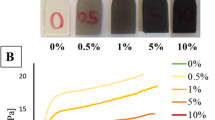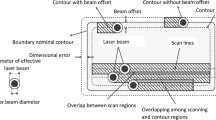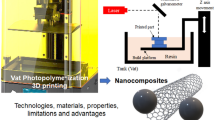Abstract
Epoxy resins are widely used polymers in the automotive and aerospace fields. Different blends of novel biodegradable resins have been studied in the last years in order to provide sustainability while maintaining the same properties of epoxy resins. Bio-based thermoset resins made with acrylated epoxidized soybean oil are well-studied in different vat polymerization techniques. The present work compares a bio-based resin and a petroleum-based resin. A benchmark with different features was designed and manufactured by a VAT photopolymerization process using both materials; measured with an optical scanning device; thus, the dimensional deviations were analyzed through inspection software. Tensile and flexural specimens were manufactured with the same procedure and tested with a dynamometer machine. Therefore, the comparison between a biodegradable resin and a petroleum-based resin is discussed in terms of the quality and mechanical performances of manufactured parts, considering the use of identical printing conditions. Some parts are required to satisfy both the requirements at the same time, such as the gears. Therefore, dimensional accuracy and mechanical strength need to be controlled and evaluated in a unique final quantification. This work proposes a novelty performance index to quantify dimensional accuracy and mechanical strength simultaneously. By combining the two aspects it is possible to define the overall performance obtained with the used material, optimizing the manufacturing process by choosing the proper material for each purpose.










Similar content being viewed by others
References
Naik N, Shivamurthy B, Thimmappa BH et al (2022) Bio-based epoxies: mechanical characterization and their applicability in the development of eco-friendly composites. J Compos Sci 6:294. https://doi.org/10.3390/jcs6100294
Afzal A, Nawab Y (2021) Polymer composites. Composite Solutions for Ballistics: 139–152. https://doi.org/10.1016/b978-0-12-821984-3.00003-6
Gopalakrishna K, Reddy N, Zhao Y (2020) Biocomposites from biofibers and biopolymers. Biofibers and Biopolymers for Biocomposites: 91–110. https://doi.org/10.1007/978-3-030-40301-0_4
Pagac M, Hajnys J, Ma Q-P et al (2021) A review of VAT photopolymerization technology: materials, applications, challenges, and future trends of 3D printing. Polymers 13:598. https://doi.org/10.3390/polym13040598
Chaudhary S, Avinashi SK, Rao J, Gautam C (2023) Recent advances in additive manufacturing, applications and challenges for dentistry: a review. ACS Biomater Sci Eng 9:3987–4019. https://doi.org/10.1021/acsbiomaterials.2c01561
Madsen B, Brøndsted P, Andersen TL (2013) Biobased composites: materials, properties and potential applications as wind turbine blade materials. Advances in Wind Turbine Blade Design and Materials: 363–386. https://doi.org/10.1533/9780857097286.3.363
Baroncini EA, Kumar Yadav S, Palmese GR, Stanzione JF (2016) Recent advances in bio-based epoxy resins and bio-based epoxy curing agents. J Appl Polym Sci. https://doi.org/10.1002/app.44103
Meier MA, Metzger JO, Schubert US (2008) Cheminform abstract: plant oil renewable resources as green alternatives in polymer science. ChemInform. https://doi.org/10.1002/chin.200805269
Shibata M (2011) Bio-based nanocomposites composed of photo-cured soybean-based resins and supramolecular hydroxystearic acid nanofibers. Soybean - Molecular Aspects of Breeding.https://doi.org/10.5772/14469
Tang Q, Chen Y, Gao H et al (2019) Bio-based epoxy resin from epoxidized soybean oil. Soybean - Biomass, Yield and Productivity. https://doi.org/10.5772/intechopen.81544
Sabbatini B, Cambriani A, Cespi M et al (2021) An overview of natural polymers as reinforcing agents for 3D printing. ChemEngineering 5:78. https://doi.org/10.3390/chemengineering5040078
Skliutas E, Lebedevaite M, Kasetaite S et al (2020) A bio-based resin for a multi-scale optical 3D printing. Sci Rep. https://doi.org/10.1038/s41598-020-66618-1
Sarabia-Vallejos MA, Rodríguez-Umanzor FE, González-Henríquez CM, Rodríguez-Hernández J (2022) Innovation in additive manufacturing using polymers: a survey on the technological and material developments. Polymers 14:1351. https://doi.org/10.3390/polym14071351
Badanova N, Perveen A, Talamona D (2022) Study of SLA printing parameters affecting the dimensional accuracy of the pattern and casting in rapid investment casting. J Manuf Mater Process 6:109. https://doi.org/10.3390/jmmp6050109
Brighenti R, Marsavina L, Marghitas MP et al (2022) Mechanical characterization of additively manufactured photopolymerized polymers. Mech Adv Mater Struct 30:1853–1864. https://doi.org/10.1080/15376494.2022.2045655
Tulcan A, Vasilescu MD, Tulcan L (2021) Comparative study of the influence of bio-resin color on the dimension, flatness and straightness of the part in the 3D printing process. Polymers 13:1412. https://doi.org/10.3390/polym13091412
Rubayo DD, Phasuk K, Vickery JM et al (2021) Influences of build angle on the accuracy, printing time, and material consumption of additively manufactured surgical templates. J Prosthet Dent 126:658–663. https://doi.org/10.1016/j.prosdent.2020.09.012
Hada T, Kanazawa M, Iwaki M et al (2020) Effect of printing direction on the accuracy of 3D-printed dentures using stereolithography technology. Materials 13:3405. https://doi.org/10.3390/ma13153405
Poyraz O (2023) Influence of build direction and post processes on the material and part attributes of hard resins fabricated by photopolymerization based additive manufacturing. Mater Res. https://doi.org/10.1590/1980-5373-mr-2022-0362
Loflin WA, English JD, Borders C et al (2019) Effect of print layer height on the assessment of 3D-printed models. Am J Orthod Dentofacial Orthop 156:283–289. https://doi.org/10.1016/j.ajodo.2019.02.013
Favero CS, English JD, Cozad BE et al (2017) Effect of print layer height and printer type on the accuracy of 3-dimensional printed orthodontic models. Am J Orthod Dentofacial Orthop 152:557–565. https://doi.org/10.1016/j.ajodo.2017.06.012
Boca M, Sover A, Slătineanu L (2021) The printing parameters effects on the dimensional accuracy of the parts made of photosensitive resin. Macromol Symp 396:2000287. https://doi.org/10.1002/masy.202000287
Chockalingam K, Jawahar N, Chandrasekhar U (2006) Influence of layer thickness on mechanical properties in stereolithography. Rapid Prototyp J 12:106–113. https://doi.org/10.1108/13552540610652456
Miedzińska D, Gieleta R, Popławski A (2020) Experimental study on influence of curing time on strength behavior of SLA-printed samples loaded with different strain rates. Materials 13:5825. https://doi.org/10.3390/ma13245825
Wu J, Zhao Z, Hamel CM et al (2018) Evolution of material properties during free radical photopolymerization. J Mech Phys Solids 112:25–49. https://doi.org/10.1016/j.jmps.2017.11.018
Chantarapanich N, Puttawibul P, Sitthiseripratip K et al (2013) Study of the mechanical properties of photo-cured epoxy resin fabricated by stereolithography process. Songklanakarin J Sci Technol (SJST) 35:91–98
Zhu C, Li S, Cong X, Liu X (2020) Mechanical properties of bio-based epoxy composites reinforced with hybrid-interlayer ramie and recycled carbon fibres. Open J Compos Mater 10:118–133. https://doi.org/10.4236/ojcm.2020.104009
Liu ZS, Erhan SZ, Calvert PD (2004) Solid freeform fabrication of epoxidized soybean oil/epoxy composites with di-, tri-, and polyethylene amine curing agents. J Appl Polym Sci 93:356–363. https://doi.org/10.1002/app.20412
Chandrashekhara K, Sundararaman S, Flanigan V, Kapila S (2005) Affordable composites using renewable materials. Mater Sci Eng A 412:2–6. https://doi.org/10.1016/j.msea.2005.08.066
Jin F-L, Park S-J (2008) Impact-strength improvement of epoxy resins reinforced with a biodegradable polymer. Mater Sci Eng A 478:402–405. https://doi.org/10.1016/j.msea.2007.05.053
Vendittoli V, Polini W, Walter MSJ (2022) Geometrical deviations of green parts due to additive manufacturing: a synthetic geometrical performance index. Procedia CIRP 114:159–164. https://doi.org/10.1016/j.procir.2022.10.036
Vendittoli V, Polini W, Walter MSJ, Moroni G (2022) Geometrical deviations of green parts by vat photopolymerization: a synthetic geometrical performance index. Proceeding: International conference on design for 3d printing, online, September 22–23, 2022
Rebaioli L, Fassi I (2017) A review on benchmark artifacts for evaluating the geometrical performance of additive manufacturing processes. Int J Adv Manuf Technol 93:2571–2598. https://doi.org/10.1007/s00170-017-0570-0
ASTM D 638-14, Standard test method for tensile properties of plastic. American Society for Testing and Materials; 2022
ASTM D 790, Plastics (I). Standard test methods for flexural properties of unreinforced and reinforced plastics and electrical insulating materials, Annual book of ASTM standards. American Society for Testing and Materials; 2003
PrusaSlicer 2.5.0 Software. https://www.prusa3d.com/page/prusaslicer_424/. Accessed 1 Feb 2023
GOM ATOS Core products. https://www.gom.com/en/products/3d-scanning. Accessed 1 Feb 2023
GOM Inspect software. https://www.gom.com/en/products/gom-suite/gom-inspect-pro. Accessed 1 Feb 2023
ASTM D 883-20b, Standard terminology relating to plastics. Americal Society for Testing and Materials; 2022
Nowacki B, Kowol P, Kozioł M et al (2021) Effect of post-process curing and washing time on mechanical properties of MSLA printouts. Materials 14:4856. https://doi.org/10.3390/ma14174856
Minitab support, ANOVA. https://support.minitab.com/en-us/minitab/20/help-and-how-to/statistical-modeling/anova/supporting-topics/basics/what-is-anova/. Accessed 27 Jul 2023
Derahman A, Abidin ZZ (2021) Mechanical properties of bio-epoxy resins and synthetic epoxy resins blends. IOP Conference Series: Mater Sci Eng 1176:012005. https://doi.org/10.1088/1757-899x/1176/1/012005
Qi M, Xu Y-J, Rao W-H et al (2018) Epoxidized soybean oil cured with tannic acid for fully bio-based epoxy resin. RSC Adv 8:26948–26958. https://doi.org/10.1039/c8ra03874k
Titow WV (1990) Plasticisers. PVC Plastics: 177–257. https://doi.org/10.1007/978-94-011-3834-5_5
Author information
Authors and Affiliations
Contributions
All authors contributed to the study conception and design. Material preparation, data collection, and analysis were performed by Valentina Vendittoli. The first draft of the manuscript was written by Valentina Vendittoli, and all authors commented on previous versions of the manuscript. All authors read and approved the final manuscript.
Corresponding author
Ethics declarations
Conflict of interest
The authors declare no competing interests.
Additional information
Publisher's Note
Springer Nature remains neutral with regard to jurisdictional claims in published maps and institutional affiliations.
Rights and permissions
Springer Nature or its licensor (e.g. a society or other partner) holds exclusive rights to this article under a publishing agreement with the author(s) or other rightsholder(s); author self-archiving of the accepted manuscript version of this article is solely governed by the terms of such publishing agreement and applicable law.
About this article
Cite this article
Vendittoli, V., Polini, W. & Walter, M.S.J. An overall performance index to quantify dimensional accuracy and mechanical strength of parts manufactured through VAT photopolymerization in biodegradable and non-biodegradable resin. Int J Adv Manuf Technol 128, 5491–5502 (2023). https://doi.org/10.1007/s00170-023-12285-1
Received:
Accepted:
Published:
Issue Date:
DOI: https://doi.org/10.1007/s00170-023-12285-1




